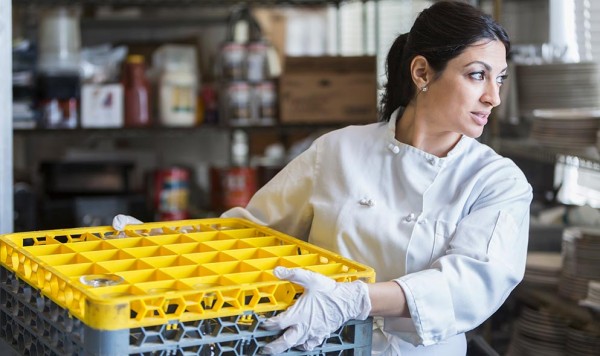latest
Supply, Labor Strains Squeeze Restaurants, Supermarkets

By Chris Lisinski
Supermarkets are turning to different brands than they normally stock in order to fill empty shelves, restaurants have pared back menus to cope with a limited pool of available ingredients, and prices across the board are on a steady climb.
Welcome to the food industry during a time of supply chain struggles.
As the federal government takes aim at shipping bottlenecks and meat processing market shares, restaurant and grocery leaders in Massachusetts say they continue to struggle under the combined pressures of inflation, low stock and labor shortages.
“It’s a confluence of all of the events,” Bob Luz, president of the Massachusetts Restaurant Association, told the News Service. “There’s a shortage of truckers, a shortage of warehouse workers, a shortage of pickers, a shortage of meat-cutters. It’s just wreaking havoc on the entire retail world.”
While supply chain struggles stretch back to the early days of the COVID-19 pandemic, when the virus and public health response prompted a slowdown in manufacturing and shipping, the omicron variant and increasingly common labor shortages have thrust the issue back into the spotlight in recent months.
In October, the American Trucking Association estimated the nation was 80,000 drivers short of what it needed to meet freight demand.
The trucking industry is not alone: businesses in virtually every sector have described staffing challenges, particularly since the omicron variant burst onto the scene about two months ago and prompted another winter surge in COVID-19 infections.
And in the complex web of shipping, cracks in one link in the chain can disrupt others down the line.
Massachusetts Food Association Senior Vice President Brian Houghton, whose group represents supermarket and grocery store businesses, recounted the struggles of one MFA member whose bakery prepares bread for other companies to sell.
The bakery’s staff recently complained they couldn’t get “any of the ingredients that they need to make the products,” Houghton said, which cut into the business and also prevented other stores from stocking its bread.
Many grocers are now grappling with a choice as a result of the strained supply chain: allow some shelves to go empty, or offer customers different brands and products than they have come to expect.
“Say you’re in the dairy aisle. You’re going to see different names or different brands of what is usually seen because everybody’s working to get substitute products,” Houghton said. “They just can’t get the products that they’ve usually gotten in the past, and that trickles all the way back to coming in at the ports, which are slow.”
Houghton said he began hearing about disruptions during the summer. Restaurants, too, have been grappling with unavailable products “pretty routinely for months, not weeks,” according to Luz.
To manage the uncertainty, Luz said many of the 5,000 Bay State restaurants his group represents have had to revamp their menus. Some have pared back their offerings altogether to “stick to ingredients that they know are not having a disruption in the supply chain,” he said.
“It’s hard enough if you’re shopping for a family, but imagine you have a menu you’re supposed to deliver to the guests each week,” Luz said. “For instance, all of a sudden chicken wings go out of stock. How does a restaurant go out of stock on chicken wings?”
At the Greater Boston Food Bank, supply chain issues pose a “conundrum,” the organization’s president and CEO Catherine D’Amato said Wednesday.
She told the New England Council that products that would normally arrive in two to three weeks are now arriving in five to seven weeks. On top of the delays, the food bank has grappled with a “10 to 20 percent increase” in the cost of food that it purchases wholesale.
Some products such as shelf-stable milk and eggs weren’t available at certain times, she said.
“Pork was a problem because of the factories or because of where they were making it, the workers got sick, and when the workers got sick, they couldn’t produce the product,” D’Amato said. “You saw all of that happen before, and that’s happening again.”
“This is going to continue,” she added. “We know that the volatility in the supply chain, whether it be food or non-food, is going to continue, depending on when those products are made, are they being made in the United States or are they being imported.”
President Joe Biden stood up a Supply Chain Disruptions Task Force over the summer and tasked it with crafting a response to ease the pressure on distributors and businesses.
Some steps the administration has taken so far include proposing fees on ocean carriers that left import containers at Los Angeles and Long Beach ports for too long and funding pop-up inland ports in Savannah, Georgia to alleviate congestion, according to John Porcari, the Port Envoy to the White House Supply Chain Task Force.
Biden on Monday also announced the federal government would steer $1 billion in American Rescue Plan Act funding to expand processing capacity in the meat and poultry industry, with his office warning that a handful of companies controlling most of the market creates a “key bottleneck in the food supply chain.”
“It’s hard to tell if the supply chain pressures are peak — have peaked,” Porcori said during a Wednesday press briefing, according to a White House transcript. “I think what is clear is the pandemic laid bare what was the underlying reality, which was the supply chain was stressed even before the pandemic. And we clearly have changes to make to build a more durable, resilient supply chain.”
The Massachusetts restaurant industry expected to face a “significant labor shortage” around this time as Baby Boomers retire at a faster rate than new workers join, Luz said, a trend exacerbated by the pandemic.
Labor issues are not limited to for-profit businesses, either. Like restaurants and grocery stores, the Greater Boston Food Bank is “challenged” to attract employees, D’Amato said in her New England Council appearance.
D’Amato told the council that increasing base wages is a “huge starting point for addressing food insecurity” because it could help attract more employees to help fight hunger.
“I compete with every retailer that has a warehouse. I compete with Amazon, I compete with Walmart,” D’Amato said. “That wage will make a difference. We all want to retain our workers and we all want them to live healthy lives. I do. My hope is that other businesses do, too. I think you can do well by doing good with your workers.”





MitzySkritzy
January 8, 2022 at 5:57 pm
Input costs for baking supplies on most items have tripled. Soon you will be pushing wheelbarrels of cash to buy a loaf of bread or the federal reserve will need to print currency notes in denominations you’ve probably never seen. Think this is nonsense or fear mongering, look at history or you will be doomed to repeat it!